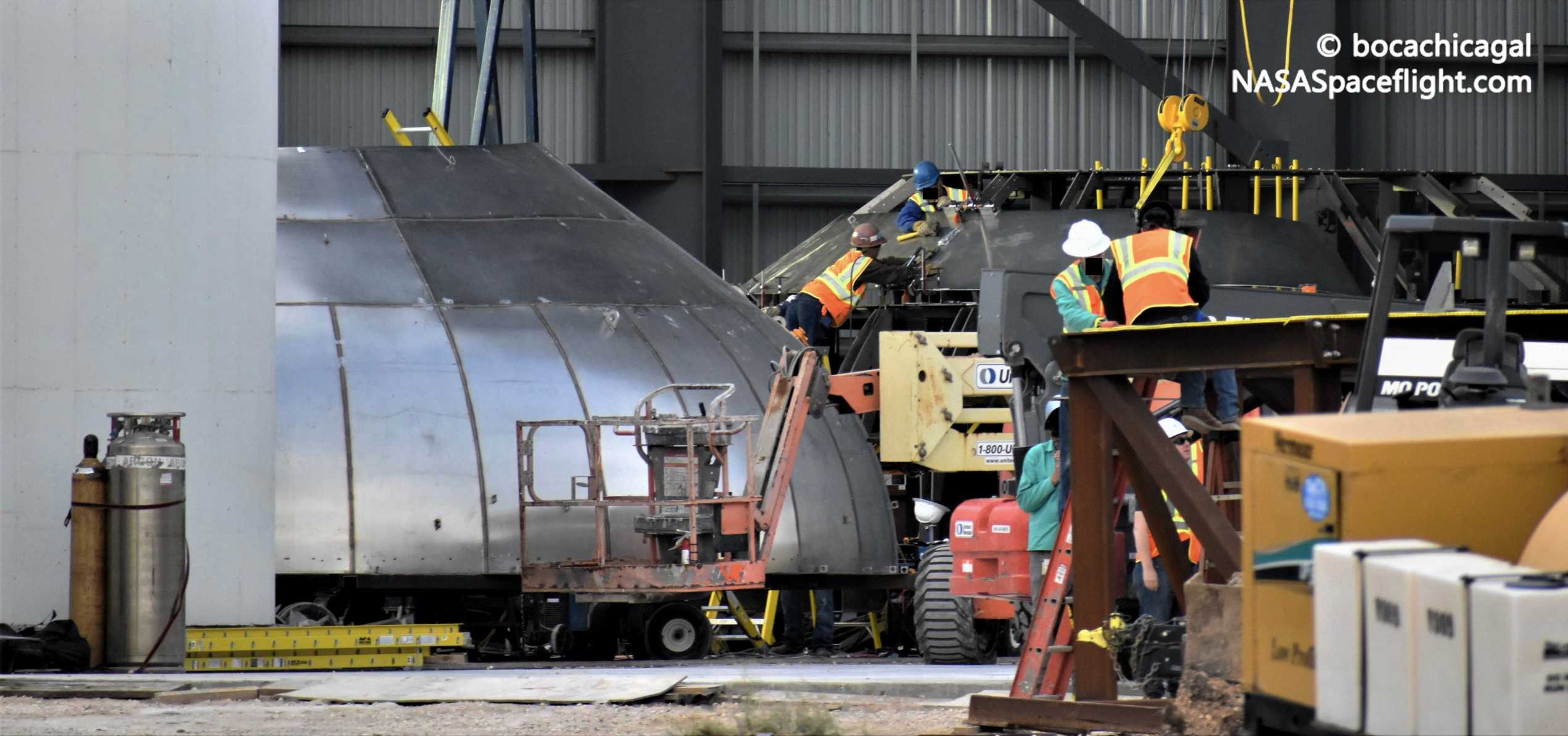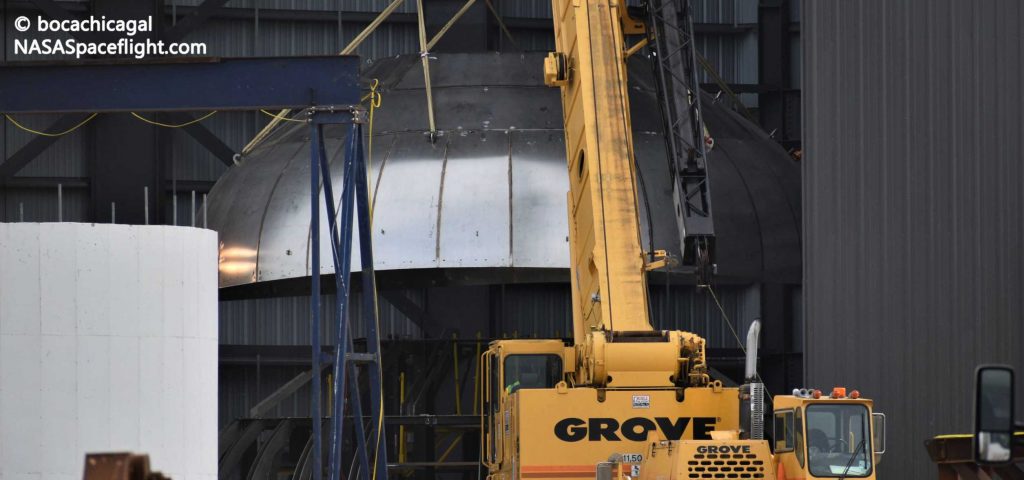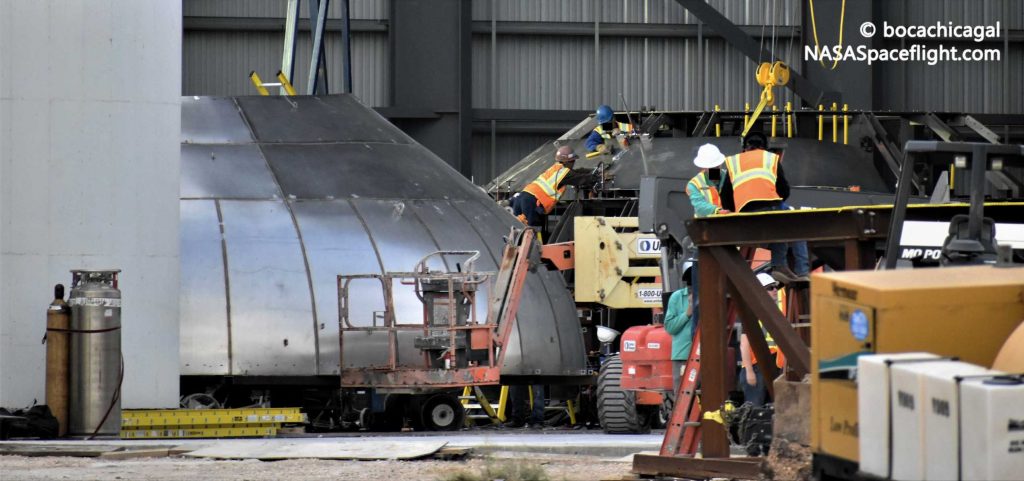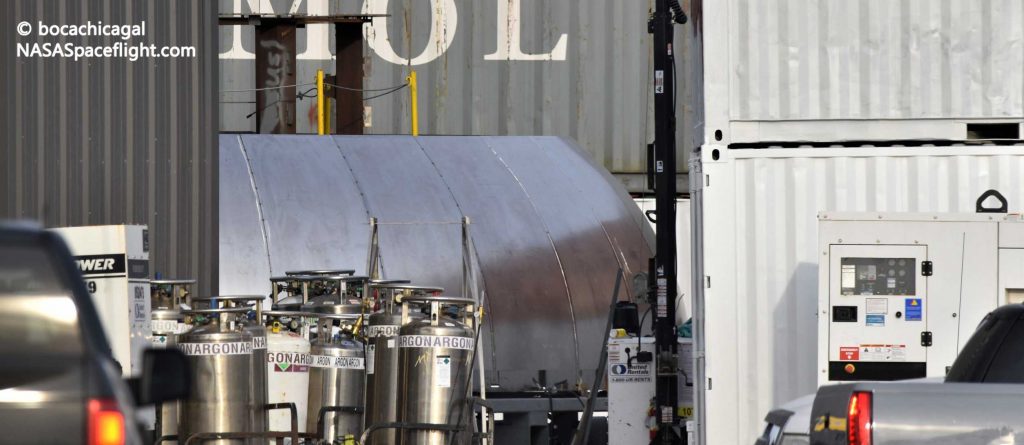

News
SpaceX's Elon Musk works through holidays on Starship's "most difficult part"
SpaceX CEO Elon Musk says he has been working through the holidays at the company’s Boca Chica facilities to get Starship’s “most difficult part” ready for the next-generation spacecraft’s next prototype and flight tests.
Known as tank domes or bulkheads, Musk says that the hardware is the most difficult part of building and assembly Starship’s primary structure, referring to the steel engine section, tanks, and pointed nose that comprise most of the spaceship’s body. Starship’s primary structure must stand up to the rigors of all aspects of flight, including highly-pressurized propellant tanks, extreme G-forces during launches, orbital reentry, and more.
It was never officially determined whether the failure was intentional or not but during the first Starship prototype’s (Mk1) last test campaign, the vehicle experience an overpressure event while being filled with liquid oxygen or nitrogen. Localized to the weld connecting the upper tank dome to Starship’s cylindrical tank section, the dome essentially sheared off at the weld and launched hundreds of feet into the air, sending a shockwave through the vehicle that crumpled many of its steel structures as if they were aluminum foil.
It’s likely that Starship Mk1’s failure was an intentional overpressure event, meaning that SpaceX may have purposely pressed the vehicle’s tanks beyond their design limits to determine how structurally sound they were. What is less clear is whether the rocket burst before or after reaching its theoretical design limit.
For reference, SpaceX’s Falcon 9 rocket operates with its fuel and oxygen tanks pressurized to about 50 psi (3.5 atm) with localized pressures likely doubling or tripling near the bottom of both tanks during the first minute or two of launch. Some amateur back-of-the-envelope calculations from videos of Starship Mk1’s burst event suggest that it was pressurized to at least 60-75 psi (4-5 atm) at its upper tank dome, meaning that the pressure on its two lower domes and tank walls would have been even higher. If correct, those unofficial figures mean that Mk1 actually performed quite well considering the ramshackle facilities and unprecedentedly spartan methods used to fabricate and assemble it.
As such, Musk likely considers Starship’s tank domes the “most difficult part of [its] primary structure” in large part because of how difficult it is to make giant propellant tank domes simultaneously light and strong. Musk has previously implied that Starship Mk1 was more 200 tons (450,000 lb) empty while the ultimate goal for the spacecraft’s empty weight is closer to 120 tons, and a large portion of that weight savings will likely have to come from making its tank domes as light as possible.
In line with that educated speculation, the last month or so of SpaceX’s Starship work in Boca Chica, Texas has been marked by a distinct focus on building tank domes. In fact, Musk himself tweeted that he had worked all night with SpaceX engineers in Boca Chica in a bid to get dome production ready for Starship’s Mk3 prototype, the first Super Heavy hardware, and many more rockets to come.
Prior to Musk’s tweet, a Starship tank dome was actually shipped all the way from Florida to Texas and arrived earlier this month. Meanwhile, technicians have been briskly building up an additional dome using what appears to be a different method of integration involving new parts. SpaceX is currently attempting to weld Starship’s tank domes together from several dozen pre-formed sheets of stainless steel.
The sheets of steel assembled into the dome Musk showed on December 27th likely arrived in Boca Chica on December 13th, implying that SpaceX has managed to complete the majority of the first dome prototype – using a new process – in barely two weeks.




After SpaceX lifted the partially-completed dome off one of its custom assembly jigs, workers almost instantly began staging new sections of steel, beginning the process of integrating yet another tank dome – now likely the fourth on-site in Boca Chica. Meanwhile, at a nearby section of SpaceX’s Boca Chica production facilities, yet another dome was visible on the 28th. In short, SpaceX should soon have more than enough tank domes to complete the next Starship prototype – said to be a significantly improved and refined design compared to Mk1.
Known as Starship Mk3 (or Starship SN01), Musk says that the rocket – currently just a miscellaneous collection of separate parts – could (“hopefully”) be ready for its first flight as soon as February or March 2020.
Check out Teslarati’s Marketplace! We offer Tesla accessories, including for the Tesla Cybertruck and Tesla Model 3.
News
Tesla cleared in Canada EV rebate investigation
Tesla has been cleared in an investigation into the company’s staggering number of EV rebate claims in Canada in January.

Canadian officials have cleared Tesla following an investigation into a large number of claims submitted to the country’s electric vehicle (EV) rebates earlier this year.
Transport Canada has ruled that there was no evidence of fraud after Tesla submitted 8,653 EV rebate claims for the country’s Incentives for Zero-Emission Vehicles (iZEV) program, as detailed in a report on Friday from The Globe and Mail. Despite the huge number of claims, Canadian authorities have found that the figure represented vehicles that had been delivered prior to the submission deadline for the program.
According to Transport Minister Chrystia Freeland, the claims “were determined to legitimately represent cars sold before January 12,” which was the final day for OEMs to submit these claims before the government suspended the program.
Upon initial reporting of the Tesla claims submitted in January, it was estimated that they were valued at around $43 million. In March, Freeland and Transport Canada opened the investigation into Tesla, noting that they would be freezing the rebate payments until the claims were found to be valid.
READ MORE ON ELECTRIC VEHICLES: EVs getting cleaner more quickly than expected in Europe: study
Huw Williams, Canadian Automobile Dealers Association Public Affairs Director, accepted the results of the investigation, while also questioning how Tesla knew to submit the claims that weekend, just before the program ran out.
“I think there’s a larger question as to how Tesla knew to run those through on that weekend,” Williams said. “It doesn’t appear to me that we have an investigation into any communication between Transport Canada and Tesla, between officials who may have shared information inappropriately.”
Tesla sales have been down in Canada for the first half of this year, amidst turmoil between the country and the Trump administration’s tariffs. Although Elon Musk has since stepped back from his role with the administration, a number of companies and officials in Canada were calling for a boycott of Tesla’s vehicles earlier this year, due in part to his association with Trump.
News
Tesla Semis to get 18 new Megachargers at this PepsiCo plant
PepsiCo is set to add more Tesla Semi Megachargers, this time at a facility in North Carolina.

Tesla partner PepsiCo is set to build new Semi charging stations at one of its manufacturing sites, as revealed in new permitting plans shared this week.
On Friday, Tesla charging station scout MarcoRP shared plans on X for 18 Semi Megacharging stalls at PepsiCo’s facility in Charlotte, North Carolina, coming as the latest update plans for the company’s increasingly electrified fleet. The stalls are set to be built side by side, along with three Tesla Megapack grid-scale battery systems.
The plans also note the faster charging speeds for the chargers, which can charge the Class 8 Semi at speeds of up to 1MW. Tesla says that the speed can charge the Semi back to roughly 70 percent in around 30 minutes.
You can see the site plans for the PepsiCo North Carolina Megacharger below.

Credit: PepsiCo (via MarcoRPi1 on X)

Credit: PepsiCo (via MarcoRPi1 on X)
READ MORE ON THE TESLA SEMI: Tesla to build Semi Megacharger station in Southern California
PepsiCo’s Tesla Semi fleet, other Megachargers, and initial tests and deliveries
PepsiCo was the first external customer to take delivery of Tesla’s Semis back in 2023, starting with just an initial order of 15. Since then, the company has continued to expand the fleet, recently taking delivery of an additional 50 units in California. The PepsiCo fleet was up to around 86 units as of last year, according to statements from Semi Senior Manager Dan Priestley.
Additionally, the company has similar Megachargers at its facilities in Modesto, Sacramento, and Fresno, California, and Tesla also submitted plans for approval to build 12 new Megacharging stalls in Los Angeles County.
Over the past couple of years, Tesla has also been delivering the electric Class 8 units to a number of other companies for pilot programs, and Priestley shared some results from PepsiCo’s initial Semi tests last year. Notably, the executive spoke with a handful of PepsiCo workers who said they really liked the Semi and wouldn’t plan on going back to diesel trucks.
The company is also nearing completion of a higher-volume Semi plant at its Gigafactory in Nevada, which is expected to eventually have an annual production capacity of 50,000 Semi units.
Tesla executive teases plan to further electrify supply chain
News
Tesla sales soar in Norway with new Model Y leading the charge
Tesla recorded a 54% year-over-year jump in new vehicle registrations in June.

Tesla is seeing strong momentum in Norway, with sales of the new Model Y helping the company maintain dominance in one of the world’s most electric vehicle-friendly markets.
Model Y upgrades and consumer preferences
According to the Norwegian Road Federation (OFV), Tesla recorded a 54% year-over-year jump in new vehicle registrations in June. The Model Y led the charge, posting a 115% increase compared to the same period last year. Tesla Norway’s growth was even more notable in May, with sales surging a whopping 213%, as noted in a CNBC report.
Christina Bu, secretary general of the Norwegian EV Association (NEVA), stated that Tesla’s strong market performance was partly due to the updated Model Y, which is really just a good car, period.
“I think it just has to do with the fact that they deliver a car which has quite a lot of value for money and is what Norwegians need. What Norwegians need, a large luggage space, all wheel drive, and a tow hitch, high ground clearance as well. In addition, quite good digital solutions which people have gotten used to, and also a charging network,” she said.
Tesla in Europe
Tesla’s success in Norway is supported by long-standing government incentives for EV adoption, including exemptions from VAT, road toll discounts, and access to bus lanes. Public and home charging infrastructure is also widely available, making the EV ownership experience in the country very convenient.
Tesla’s performance in Europe is still a mixed bag, with markets like Germany and France still seeing declines in recent months. In areas such as Norway, Spain, and Portugal, however, Tesla’s new car registrations are rising. Spain’s sales rose 61% and Portugal’s sales rose 7% last month. This suggests that regional demand may be stabilizing or rebounding in pockets of Europe.
-

 Elon Musk2 weeks ago
Elon Musk2 weeks agoTesla investors will be shocked by Jim Cramer’s latest assessment
-

 Elon Musk2 days ago
Elon Musk2 days agoxAI launches Grok 4 with new $300/month SuperGrok Heavy subscription
-

 Elon Musk4 days ago
Elon Musk4 days agoElon Musk confirms Grok 4 launch on July 9 with livestream event
-

 News1 week ago
News1 week agoTesla Model 3 ranks as the safest new car in Europe for 2025, per Euro NCAP tests
-

 Elon Musk2 weeks ago
Elon Musk2 weeks agoA Tesla just delivered itself to a customer autonomously, Elon Musk confirms
-

 Elon Musk1 week ago
Elon Musk1 week agoxAI’s Memphis data center receives air permit despite community criticism
-

 News2 weeks ago
News2 weeks agoXiaomi CEO congratulates Tesla on first FSD delivery: “We have to continue learning!”
-

 News2 weeks ago
News2 weeks agoTesla sees explosive sales growth in UK, Spain, and Netherlands in June













